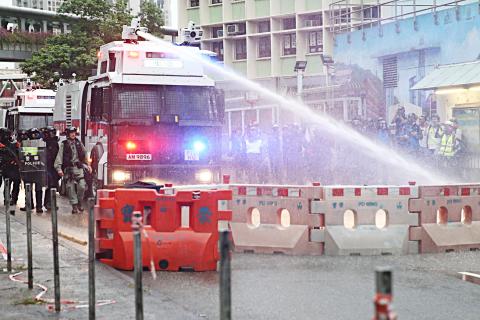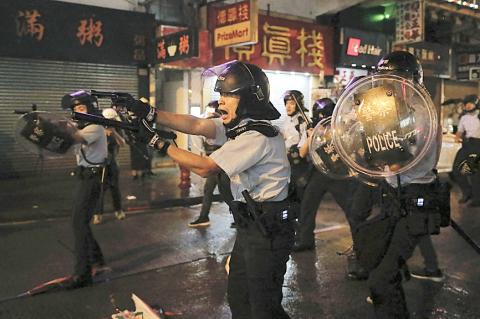Police in Hong Kong yesterday used tear gas to clear pro-democracy demonstrators who had taken over a street and brought out water cannon trucks for the first time in the summer-long protests.
The skirmish on a main drag in the Tsuen Wan district in the New Territories followed a march that ended in a nearby park.
While a large crowd rallied in the park, a group of protesters took over a main street, strewing bamboo poles on the pavement and lining up orange and white traffic barriers and cones to obstruct police.

Photo: EPA-EFE
After hoisting warning flags, police used tear gas to try to disperse the crowd. Protesters responded by throwing bricks and gasoline bombs toward the police.
The result was a surreal scene of small fires and scattered paving bricks on the street between the two sides, before the protesters abandoned their position.
Two water cannon trucks and a phalanx of police vehicles with flashing lights joined riot police on foot as they advanced up the street. They met little resistance.

Photo: AP
Television footage showed a water cannon being fired once, but perhaps more as a test, as it did not appear to reach the protesters.
Later in the evening, a Hong Kong police officer fired at least one gunshot in Tsuen Wan, the first time a live round has been used during three months of protests.
“According to my understanding, just now a gunshot was fired by a colleague... My initial understanding was that it was a uniformed policeman who fired his gun,” a Hong Kong police officer said.
Prior to the skirmishes, tens of thousands of umbrella-carrying protesters marched in the rain.
Many filled Tsuen Wan Park, the endpoint of the rally, chanting, “Fight for freedom, stand with Hong Kong,” the South China Morning Post reported.
The march in the New Territories started near the Kwai Fong train station, which has become a focal point for protesters after police used tear gas there earlier this month. Police with riot gear could be seen moving into position along the march route.
Police yesterday said they arrested 29 people on Saturday for various offenses, including unlawful assembly, possession of offensive weapons and assaulting police officers, after a large group of protesters clashed with police after a march in the Kowloon Bay neighborhood, building barricades and setting fires in the streets.
Ten people were left in hospital after Saturday’s clashes — two in a serious condition — staff said, without detailing if they were police or protesters.
Meanwhile, the territory’s metro system, the MTR, is the latest business to face public censure, after appearing to bend to Chinese state-media attacks accusing the system of being an “exclusive” service to ferry protesters to rallies.
The MTR yesterday shut stations near the main demonstration area in Tsuen Wan, in the second day of station closures in a row.
A second rally of a few hundred, some of them family members of police, yesterday criticized the government for leaving officers to handle the brunt of the crisis, while also calling for an independent investigation into the police handling of the protests.
“I believe within these two months, police have got enough opprobrium,” said a woman who asked not to be named and said she was a police officer’s wife.
“I really want you to know even if the whole world spits on you, we as family members will not. Remember, your job is to serve Hong Kong residents, not be the enemies of Hong Kong,” she said.
Additional reporting by AFP

Conflict with Taiwan could leave China with “massive economic disruption, catastrophic military losses, significant social unrest, and devastating sanctions,” a US think tank said in a report released on Monday. The German Marshall Fund released a report titled If China Attacks Taiwan: The Consequences for China of “Minor Conflict” and “Major War” Scenarios. The report details the “massive” economic, military, social and international costs to China in the event of a minor conflict or major war with Taiwan, estimating that the Chinese People’s Liberation Army (PLA) could sustain losses of more than half of its active-duty ground forces, including 100,000 troops. Understanding Chinese

The Ministry of Foreign Affairs (MOFA) yesterday said it is closely monitoring developments in Venezuela, and would continue to cooperate with democratic allies and work together for regional and global security, stability, and prosperity. The remarks came after the US on Saturday launched a series of airstrikes in Venezuela and kidnapped Venezuelan President Nicolas Maduro, who was later flown to New York along with his wife. The pair face US charges related to drug trafficking and alleged cooperation with gangs designated as terrorist organizations. Maduro has denied the allegations. The ministry said that it is closely monitoring the political and economic situation

UNRELENTING: China attempted cyberattacks on Taiwan’s critical infrastructure 2.63 million times per day last year, up from 1.23 million in 2023, the NSB said China’s cyberarmy has long engaged in cyberattacks against Taiwan’s critical infrastructure, employing diverse and evolving tactics, the National Security Bureau (NSB) said yesterday, adding that cyberattacks on critical energy infrastructure last year increased 10-fold compared with the previous year. The NSB yesterday released a report titled Analysis on China’s Cyber Threats to Taiwan’s Critical Infrastructure in 2025, outlining the number of cyberattacks, major tactics and hacker groups. Taiwan’s national intelligence community identified a large number of cybersecurity incidents last year, the bureau said in a statement. China’s cyberarmy last year launched an average of 2.63 million intrusion attempts per day targeting Taiwan’s critical

‘SLICING METHOD’: In the event of a blockade, the China Coast Guard would intercept Taiwanese ships while its navy would seek to deter foreign intervention China’s military drills around Taiwan this week signaled potential strategies to cut the nation off from energy supplies and foreign military assistance, a US think tank report said. The Chinese People’s Liberation Army (PLA) conducted what it called “Justice Mission 2025” exercises from Monday to Tuesday in five maritime zones and airspace around Taiwan, calling them a warning to “Taiwanese independence” forces. In a report released on Wednesday, the Institute for the Study of War said the exercises effectively simulated blocking shipping routes to major port cities, including Kaohsiung, Keelung and Hualien. Taiwan would be highly vulnerable under such a blockade, because it